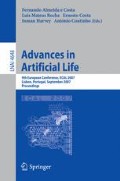Abstract
We present the dynamical analysis of embodied RNNs evolved to control a cybernetic device that solves a tracking problem. From the Neurodynamics perspective, we analyze the networks with focus on a characterization of the attractors and attractor sequences, guiding the transients. Projections of these attractors to motor space help visualizing the shape of the attractors, thus pointing to the underpinnings of behavior. Among the different attractors found are fixed points, periodic and quasi-periodic attractors of different periods, as well as chaos. Further analysis of the attractors relates changes of shape, size and period to motor control. Interesting characteristic behaviors arise, such as chaotic transitory regimes and implicit mapping of environmental assymmetricities in the network’s response, (as for example attractor hops that implicitly code for gravity). We discuss autonomy, capacity and some issues relating to a possible theory of transients.
Access this chapter
Tax calculation will be finalised at checkout
Purchases are for personal use only
Preview
Unable to display preview. Download preview PDF.
References
Beer, R.: A dynamical systems perspective on agent-environment interaction. Artificial Intelligence 72, 173–215 (1995)
Negrello, M., Pasemann, F.: Adaptive Neurodynamics. In: Yang, A., Shan, Y. (eds.) Applications of Complex Adaptive Systems, IDEA Group, Hershey (to appear, 2008)
Pasemann, F., Steinmetz, U., Huelse, M., Lara, B.: Robot control and the evolution of modular neurodynamics. Theory in Biosciences 120, 311–326 (2001)
Tsuda, I.: Toward an interpretation of dynamic neural activity in terms of chaotic dynamical systems. Behavioral and Brain Sciences 24, 793–847 (2001)
Pasemann, F.: Complex dynamics and the structure of small neural networks. Network: Computation in neural systems 13(2), 195–216 (2002), http://www.iop.org/EJ/S/0/27972/uoqgs3Z8ALGleMygUyOqrg/toc/0954-898X/13/2
Molter, C., Salihoglu, U., Bersini, H.: The road to chaos by time-asymmetric hebbian learning in recurrent neural networks. Neural Computation 19, 80–110 (2007)
Huelse, M., Wischmann, S., Pasemann, F.: Structure and function of evolved neuro-controllers for autonomous robots. Connection Science 16(4), 249–266 (2004)
Mataric, M.: Sensory-Motor Primitives as Basis for Imitation: Linking Perception to Action and Biology to Robotics. In: Imitation in Animals and Artifacts, pp. 392–422. MIT Press, Cambridge (2002)
Tani, J., Ito, M.: Self-organization of behavioral primitives as multiple attractor dynamics: A robot experiment. IEEE Transactions on Systems, Man and Cybernetics, Part A 33(4) (2003)
Varela, F.: Principles of Biological Autonomy. North Holland, Amsterdam (1979)
Varela, F., Rorty, E., Thompson, E.: The Embodied Mind. MIT Press, Cambridge (1991)
Harvey, I., Di Paolo, E., Wood, R., Quinn, M., Tuci, E.: Evolutionary robotics: A new scientific tool for studying cognition. Artificial Life 11(1-2), 79–98 (2005), http://www.mitpressjournals.org/doi/abs/10.1162/1064546053278991
Pfeifer, R., Iida, F., Bongard, J.: New robotics: Design principles for intelligent systems. Artificial Life 11(1-2), 99–120 (2005), http://www.mitpressjournals.org/doi/abs/10.1162/1064546053279017
Author information
Authors and Affiliations
Editor information
Rights and permissions
Copyright information
© 2007 Springer-Verlag Berlin Heidelberg
About this paper
Cite this paper
Negrello, M., Pasemann, F. (2007). Transients of Active Tracking: A Stroll in Attractor Spaces. In: Almeida e Costa, F., Rocha, L.M., Costa, E., Harvey, I., Coutinho, A. (eds) Advances in Artificial Life. ECAL 2007. Lecture Notes in Computer Science(), vol 4648. Springer, Berlin, Heidelberg. https://doi.org/10.1007/978-3-540-74913-4_101
Download citation
DOI: https://doi.org/10.1007/978-3-540-74913-4_101
Publisher Name: Springer, Berlin, Heidelberg
Print ISBN: 978-3-540-74912-7
Online ISBN: 978-3-540-74913-4
eBook Packages: Computer ScienceComputer Science (R0)

